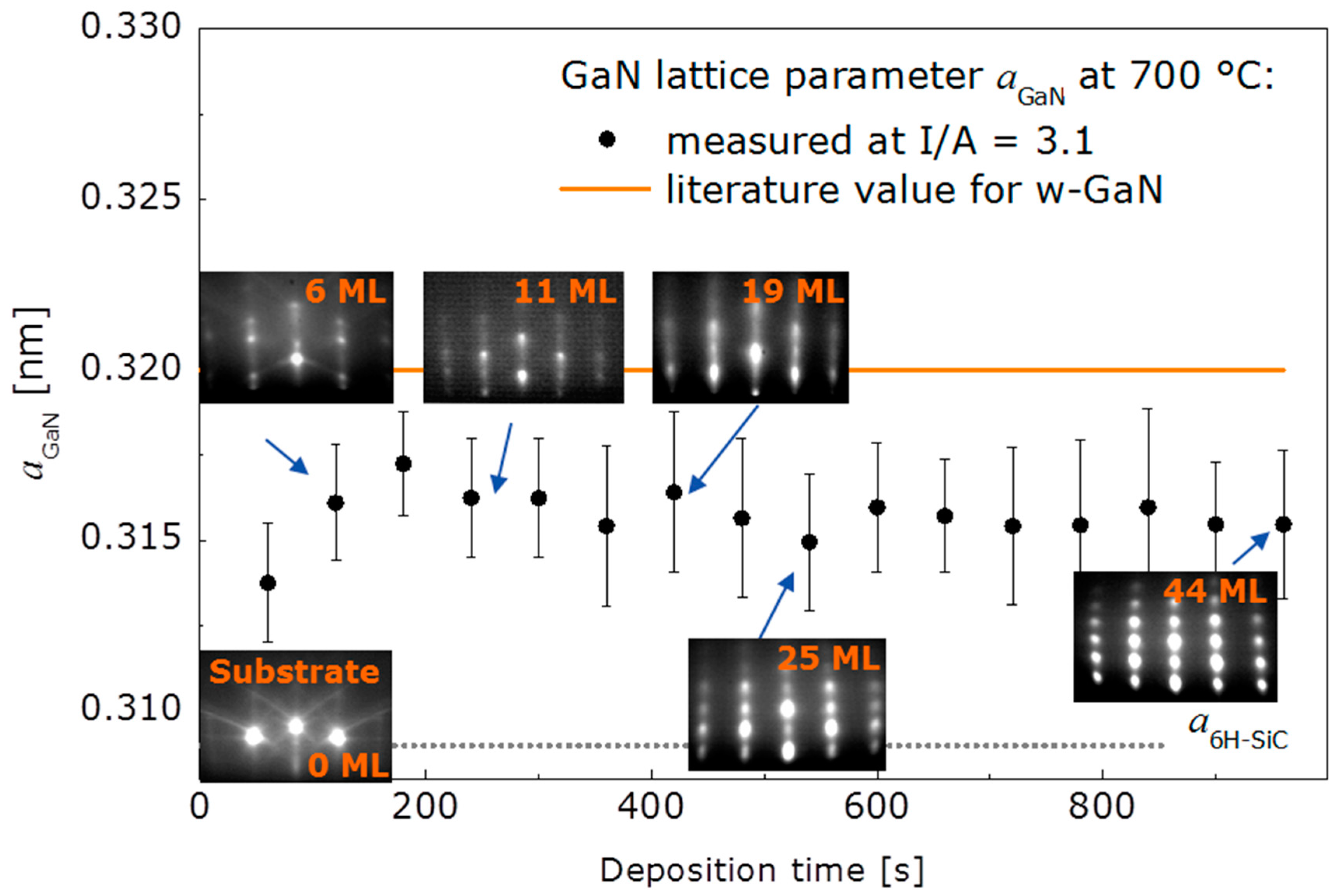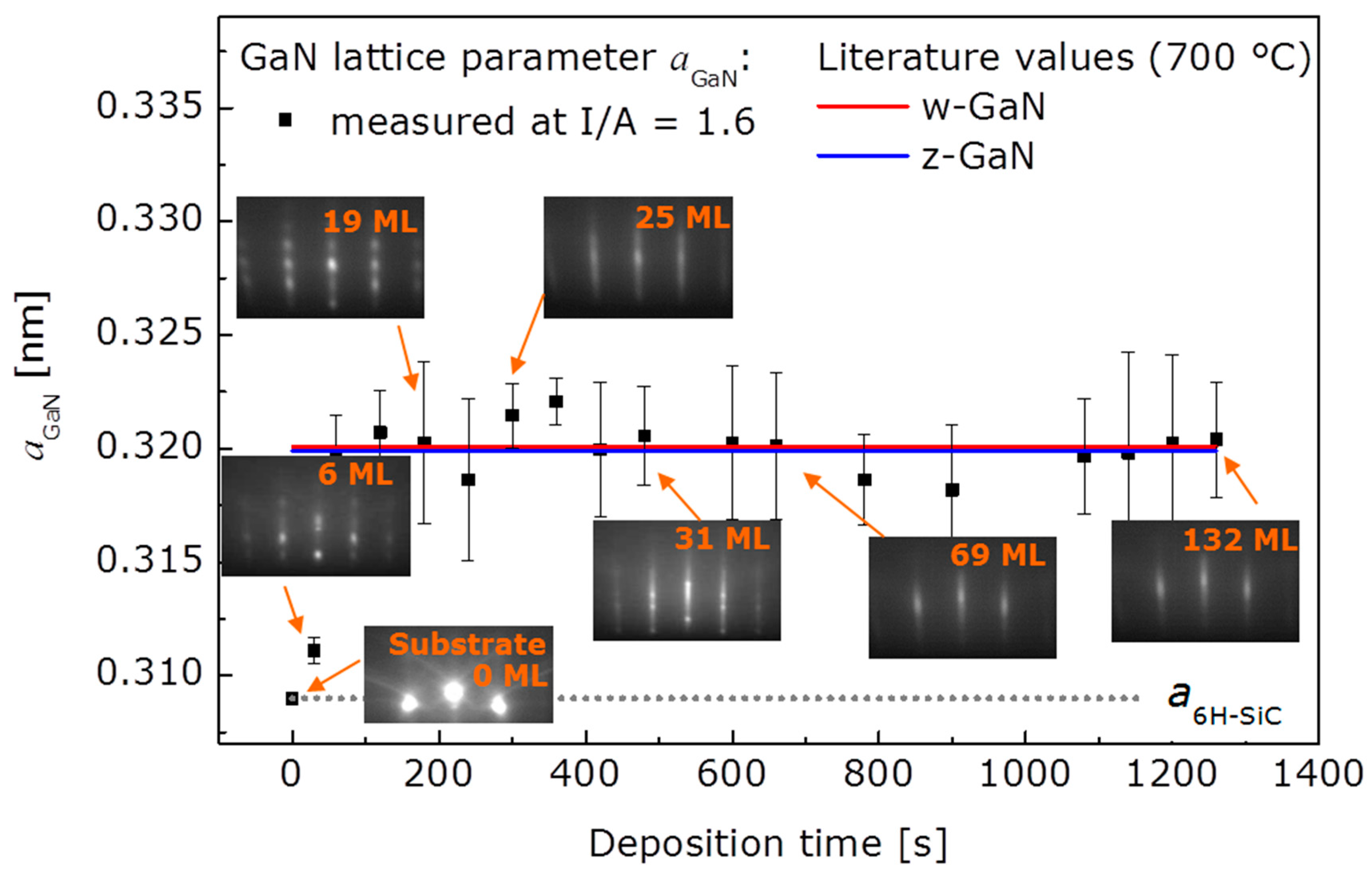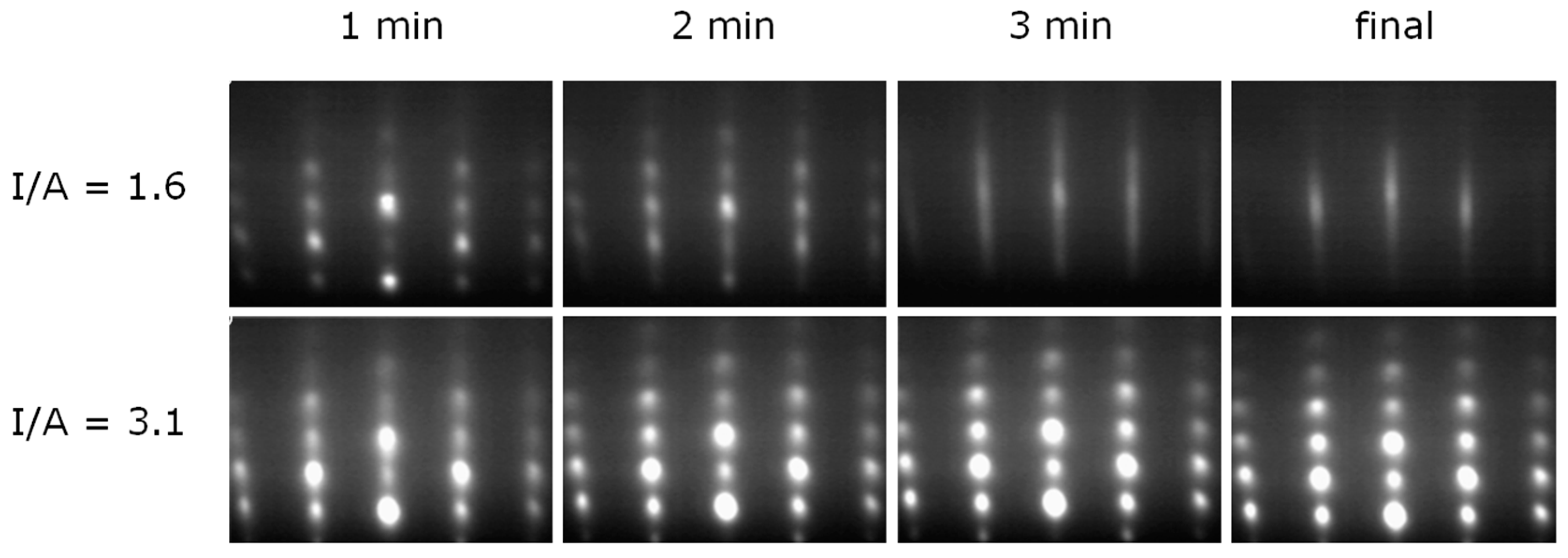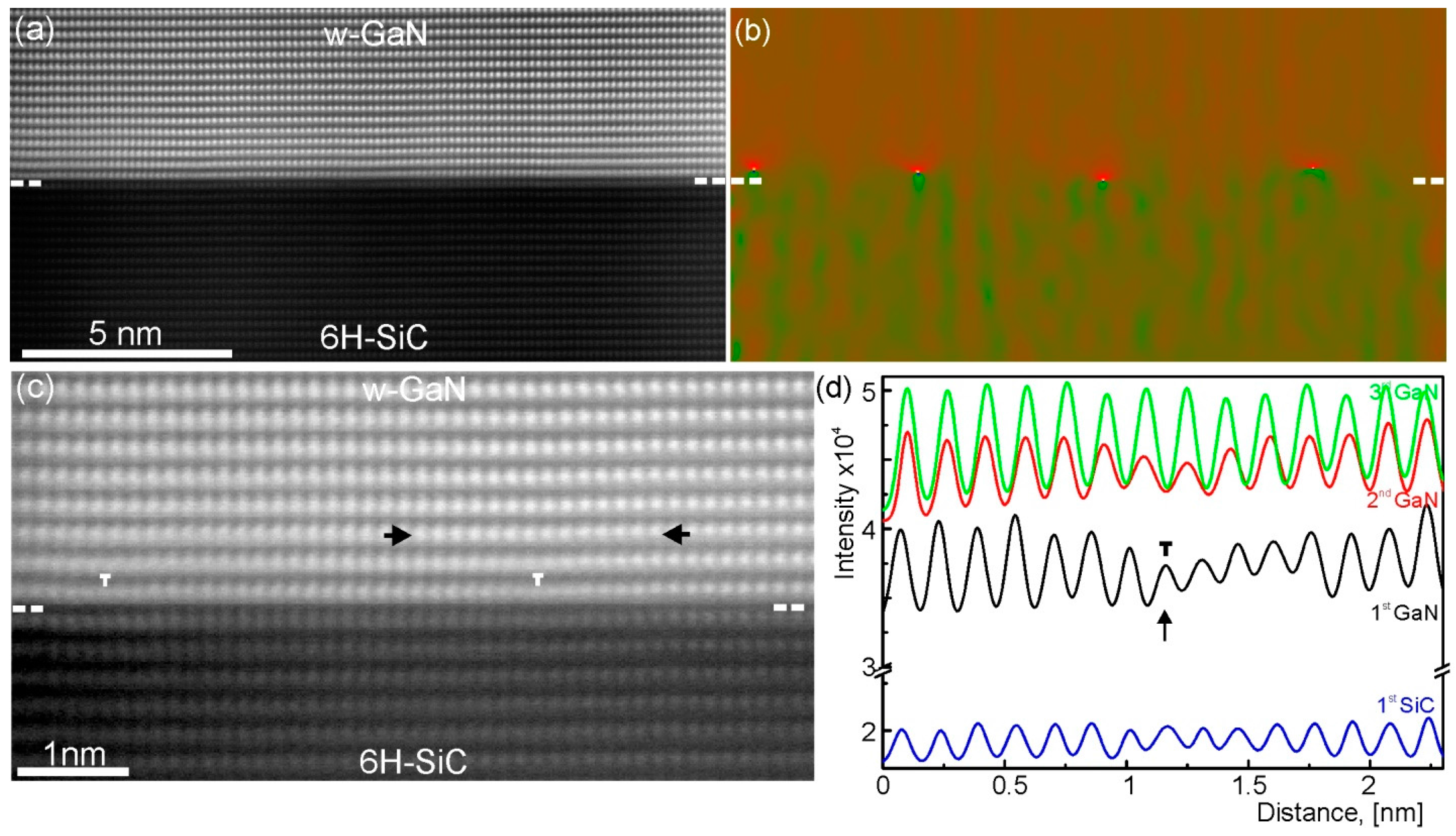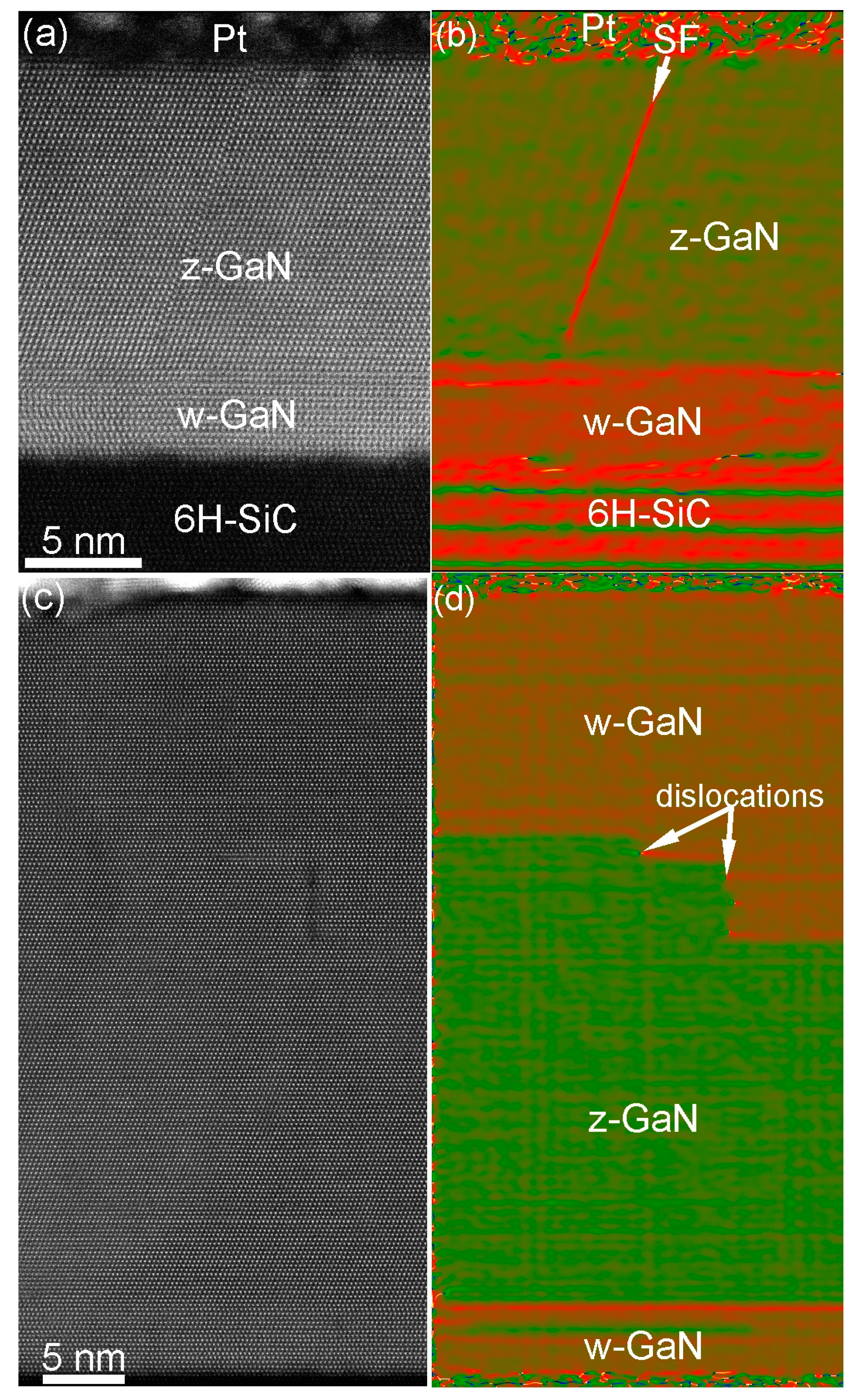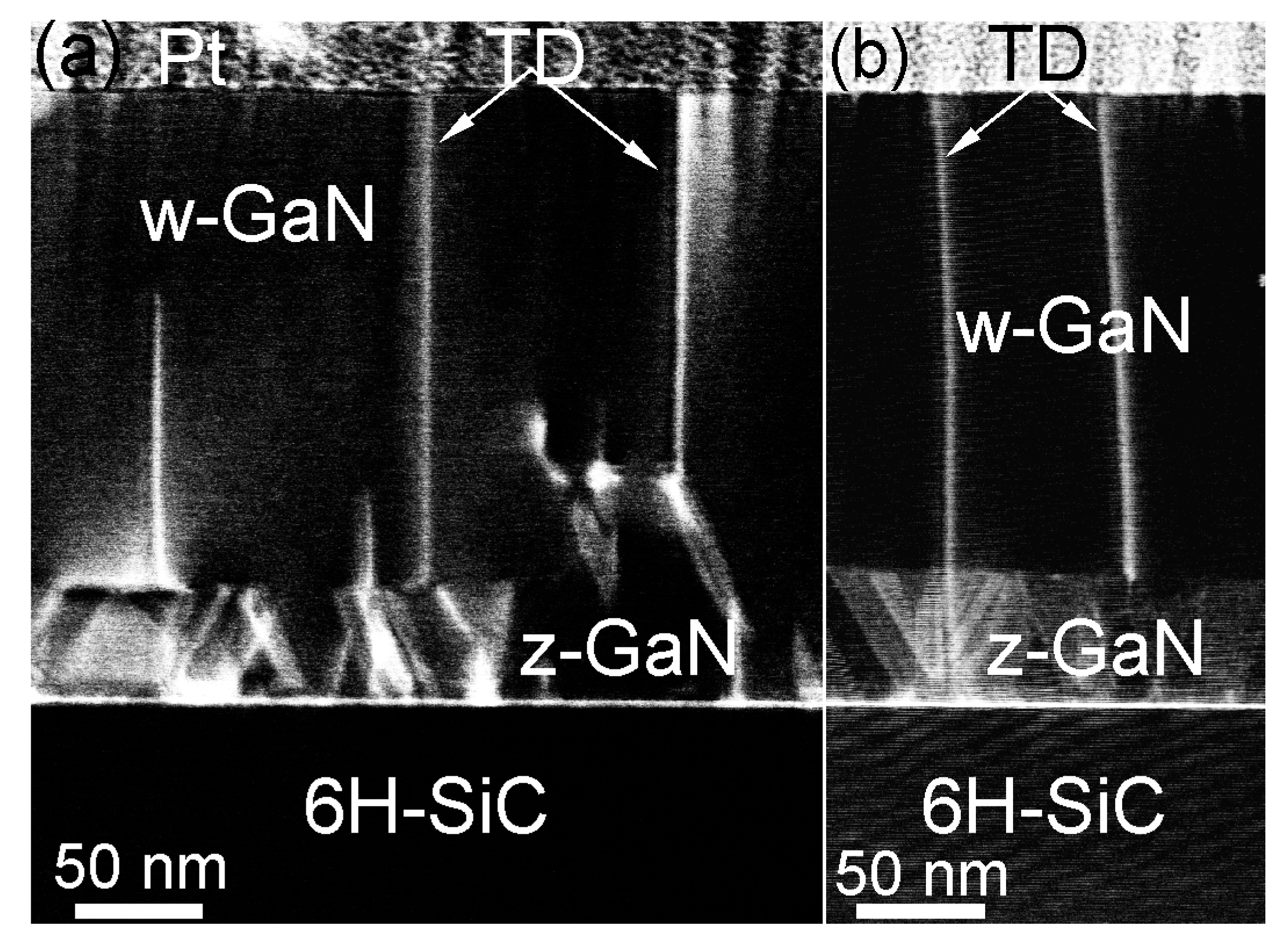2.1. Growth Characteristics
Keeping the previously optimized parameters nitrogen ion energy, nitrogen ion flux, and 6H-SiC(0001) substrate temperature constant (see
Section 4), the nitrogen ion to gallium atom flux ratio I/A was varied for the epitaxial GaN thin film deposition using IBA-MBE by solely altering the gallium atom flux. In a combined in situ reflection high-energy electron diffraction (RHEED)/in vacuo scanning tunneling microscopy (STM) study it was already reported by the authors [
4] that the growth characteristics and the resulting film properties are dependent on the I/A ratio, i.e., on the average number of impinging hyperthermal nitrogen ions per deposited Ga atom. In particular, it was found that the growth mode of the films relies crucially on the chosen I/A ratio. While three-dimensional 3D growth was dominant for I/A ratios higher than 1.9, the preferred 2D growth was accomplished only for I/A ratios below. This is of major importance, as other film properties are defined, or at least influenced, by the film growth mode. The growth rate for 3D growth at I/A = 3.1 was 0.7 nm/min and the for 2D growth at I/A = 1.6 was 1.3 nm/min, repectively. In the present study, key aspects of this influence shall be addressed in more detail. Exemplarily, in
Figure 1 the surface topography of ca. 10 nm thick GaN films obtained from STM, as well as the corresponding final RHEED patterns, are depicted for different I/A ratios. In the case of I/A = 3.1, the topography shows islands, the corresponding RHEED pattern consists of spot-like reflections, which indicates 3D growth of (0001)-oriented w-GaN. For GaN films deposited with I/A = 1.6, the topography is comparably flat with wide terraces and the RHEED pattern now consists of narrow, streak-like reflections, which are typical for 2D growth. For lower I/A ratios, this 2D growth is disturbed by secondary nucleation of (111)-oriented z-GaN islands, as indicated by the diffraction spots in the corresponding RHEED pattern. These islands appear in twinned form, i.e., they are rotated against each other around the
direction. For clarity, the arrangement of reflections in the RHEED patterns is depicted in the modelled patterns shown in the third row of
Figure 1.
In the following, two types of ca. 10 nm thick GaN films, representative for 3D (I/A = 3.1) and 2D (I/A = 1.6) growth, will be compared regarding structural properties and film growth characterstics. The θ/2θ diffraction spectra of such samples (see
Figure 2, left) show the sharp 6H-SiC(0001) reflection at 35.67° and much broader GaN(0002) reflections, due to the small film thickness, near the expected position (34.56°) indicated by the vertical dashed line. The maximum of the diffraction curve from the 3D grown film (blue) is slightly shifted to higher diffraction angles, which indicates a slight reduction of the c-axis length. The maximum of the curve for the 2D grown film (magenta) is situated at the literature value position [
5]. As the surface topography of the 2D grown films is flat, i.e., the film thickness homogeneity is high over the whole film, the reflection is accompanied by film thickness fringes. As a measure for the crystalline quality of the films, rocking curves of the GaN(0002) reflections were recorded. The rocking curve of the 3D grown film in
Figure 2 consists of two contributions, a narrow peak with a full-width at half height (FWHM) of 5 arcmin together with a broad peak with a FWHM of larger than 1°. Accordingly, such films consist of crystallites with a high order of orientation as well as of highly misaligned crystallites. In contrast, the rocking curve of the 2D grown film is one sharp peak with a FWHM of 3 arcmin being indicative of a high order of orientation, as can be expected from high crystalline quality epitaxial growth.
In order to examine the initial growth stage of 3D and 2D growth, series of RHEED patterns were recorded, allowing for the nominal film thickness dependent determination of the in-plane lattice spacing. Starting with the bare 6H-SiC(0001) substrate as a reference, the evolution of the lattice parameter a
GaN with deposition time is illustrated in
Figure 3 for the case of 3D growth. The dotted line marks the substrate reference value. Corresponding RHEED patterns are given in addition. In the beginning of 3D growth, the in-plane periodicity of the GaN islands increases and reaches the final state already after a nominal thickness of six monolayers (ML) of GaN. The final value around 0.316 nm lies below the value expected for bulk w-GaN at the growth temperature 700 °C (drawn through line in the
Figure 3). From beginning on the RHEED patterns of the growing film exhibit spot-like reflections typical for 3D growth. In comparison, the in-plane periodicity for 2D growth (see
Figure 4) evolves also with an increase in the beginning, reaching the final state within the first 6 ML, too, but the final value is in good agreement with the value expected for bulk w-GaN at the growth temperature of 700 °C. This means that the 2D grown GaN films are relaxed within the error of the measurement as already derived from the X-ray diffraction (XRD) measurements. The RHEED patterns evolution for 2D growth is more complex than for 3D growth. For reasons of clarity this is illustrated in
Figure 4. According to the upper series of RHEED patterns in
Figure 5, growth starts with the formation of well-oriented islands, indicated by sharp, spot-like reflections. This initial island growth undergoes a rapid transition to 2D growth (I/A = 1.6), as can be concluded from the change to streak-like reflections in the patterns for longer deposition times. In the shown case, this transition is accomplished after already 3 min of deposition. For 3D growth (I/A = 3.1) however, the RHEED patterns start with broad, spot-like reflections and the patterns recorded after 2 min, 3 min, and at the end of the deposition do not differ from each other anymore. This means, that while further details about the growth evolution for 3D grown films cannot be derived from the RHEED pattern, for the case of 2D growth, the crucial film growth stage of film coalescence could be observed. This is summarized in
Figure 6, which shows, schematically, the region of 3D growth, as well as the regions of 2D growth in the stage before and after film coalescence. It was found that within the region of 2D growth the coalescence thickness increased with the decreasing I/A ratio in the range from about 4 to 8 nm of GaN coverage. The achievement of such small coalescence thicknesses proves the capabilities of the IBA-MBE technique in comparison to other prominent GaN film growth techniques regarding thin and ultrathin epitaxial GaN films of high crystalline quality. In the literature, reported coalescence thicknesses for GaN film growth on 6H-SiC(0001) substrates are 25 nm [
6] and 20–70 nm [
7] for plasma-assisted molecular beam epitaxy, 70–140 nm for metalorganic vapor phase epitaxy using a thin AlN buffer layer [
8], and more than 100 nm for hydride vapor phase epitaxy [
9].
2.2. Microstructure and Defects
The characterization of GaN thin film microstructure starts from the GaN/SiC interface by Cs-corrected scanning transmission electron microscopy (STEM). Among various structural methods, this is a very powerful technique and can provide information about the local structure of functional materials in real-space with resolution down to the picometer scale [
10]. Atomic-resolution low-angle annular dark-field scanning transmission electron microscopy (LAADF-STEM) images of the GaN/SiC interface in
viewing directions of GaN and SiC lattices are shown in
Figure 7. Qualitative interpretation of such STEM images is quite straightforward since the image intensities are proportional to the atomic number, as ~Z
1.8 and the atomic columns with higher average Z number in the LAADF-STEM or high-angle annular dark-field scanning transmission electron microscopy (HAADF-STEM) images appear brighter than the columns with lower average Z number [
11]. The GaN/SiC interface in
Figure 7 is epitaxial and atomically flat. Due to the LAADF imaging conditions [
10], the light and heavy elements are seen at the GaN/SiC interface. A large number of basal plane-like stacking faults (SFs) of intrinsic type originate directly at the GaN/SiC interface. However, regions with the hexagonal stacking sequence of the w-GaN were also found. The SFs do not propagate through the whole layer and are not bounded by partial dislocations. The SFs are mainly concentrated in the first three layers of GaN. In addition, gallium atomic columns with double positions were observed in the first and the second layers of the GaN (description shown latter in the text). The misfit or edge dislocations are not seen in this viewing direction since they are inclined. To image the core structure of these dislocations, the STEM specimen was tilted by 30° around the GaN
axis. It should be noted that no threading dislocations were identified by
g·b analysis of dislocations using
g = 0002 and
g =
viewed along the GaN
zone axis (
b is the Burgers vector).
The averaged Ga to Ga distance in the first GaN layer calculated in the areas with the hexagonal stacking sequence of the w-GaN along the GaN direction was estimated to be about 0.272 nm, which is 1.5% smaller compared to the calculated distances in the second layer and to the measured distances of defect-free GaN close to the surface (0.276 nm). The averaged distance in SiC in the direction was measured to be 0.266 nm which is about 2.2% smaller than the measured distances in the first GaN layer. Thus, the lattice mismatch between the SiC substrate and the GaN film is compensated in the first monolayer of the GaN. The atomic structure of the first GaN layers and of the GaN/SiC interface viewed along the GaN zone axis is presented below.
A high-resolution HAADF-STEM image of the GaN/SiC interface in the
viewing directions of GaN and SiC lattices is given in
Figure 8a. The interface between the thin film and substrate is epitaxial. The areas containing line defects at the interface are blurred. Line profile analysis shown in
Figure 8b reveals that the first Ga layers are well matched to the substrate with distances very close to the substrate distances. The edge dislocations appear in the second Ga layers. However, analysis of larger areas revealed that misfit dislocations between the thin film and SiC substrate can be also formed.
Figure 8c,d shows the HAADF image and geometrical phase analyses of
Figure 8c, respectively. The strain areas due to misfit and edge dislocations are seen in the image
Figure 8b. Both of these types of dislocations are aligned along the
directions with a Burgers vector
b = 1/3
. These dislocations lie parallel to the interface on the (0001) basal planes [
12]. The measured separation distance between these dislocations is about 4.6 nm which is close to the expected 4.77 nm calculated from bulk values. However, the arrangement of these dislocations is not uniform and the position of the dislocation cores can vary by ±1.5 nm. These results indicate that the misfit strain during thin film growth can be accommodated by two mechanisms. The first mechanism is based on the formation of misfit dislocations which are typical for heteroepitaxial growth of highly mismatched compounds. The second mechanism is differing from the known mechanisms. It is based on the formation of highly strained first monolayer adopting substrate symmetry with subsequent formation of edge dislocations in the following layers.
Schematic representations of the local structure at the GaN/SiC interface in
and
viewing directions are shown in
Figure 9a,b.
Figure 9a shows edge dislocation in the GaN whereas
Figure 9b represents the defect with double Ga positions similar to the image in
Figure 7. This defect can be seen as overlapping two parts of the GaN layer and can be constructed assuming Amelinckx et al.’s stacking mismatch boundary [
13]. The extra plane in
Figure 9a can belong either to the right or to the left part of the GaN monolayer. Image simulation based on the model of
Figure 9b is shown in
Figure 9c. The image contrast of the experimental image due to the defect can be reproduced well in simulated STEM images, confirming the models in
Figure 9a,b. Thus, this defect is not due to steps at the 6H-SiC substrate which was discussed as the main source of the formation of Amelinckx et al.’s stacking mismatch boundary [
14,
15]. The formation of this defect is more likely during the growing process where the diffusing Ga and N adatoms try to match the substrate symmetry forming such overlapping regions.
Above the first, second, and third GaN layers, the thin film growth proceeds by the formation of w-GaN up to a thickness of approximately 4 nm.
Figure 10a–d shows HAADF-STEM images of GaN thin film with various overall thicknesses. A well-defined layer of w-GaN is presented in both samples. The typical defects in these regions were identified as basal-plane stacking faults (SFs), grain, twin, and stacking mismatch boundaries [
13]. Above this 4 nm thick w-GaN layer, GaN growth continues with the formation of z-GaN. However, the thickness of this layer was varied depending on the GaN thin film thickness [
13]. In
Figure 10a the thickness of z-GaN is 14 nm whereas for thicker sample shown in
Figure 10c the thickness of z-GaN is varying between 22 and 30 nm. Consequently, GaN thin film consisting of mainly z-GaN can be grown on top of thin w-GaN layer by IBA-MBE. Intrinsic SFs and grain boundaries are usual defects within of this z-GaN layer. Above the z-GaN layer, only w-GaN is observed after GaN thin film growth. The transition between z-GaN and w-GaN grains is smooth. The grains are connected by low-angle grain boundaries bounded by dislocations. The w-GaN layer on top of the z-GaN layer contains a lower density of planar defects comparing to the w-GaN and z-GaN layers close to the interface. Only some rarely distributed basal-plane SFs and grain boundaries were found during HAADF-HRSTEM studies.
The above described defects and GaN layer sequences were also observed in GaN thin film with a thickness of more than 200 nm. In addition, threading dislocations (TDs) are found in such thin films (
Figure 11). The bright areas in
Figure 11a,b are due to strain contrast caused by electron de-channeling effects at defect areas. The source of TDs was found to be different. TDs can be formed at the interface area and propagate through the whole thin film thickness. Moreover, TDs can be nucleated at pre-existing defects in z-GaN layer. The TDs can be also stopped at some thickness of GaN. Since identification of density of TDs from STEM requires large TEM specimen areas, the TDs density was first estimated from XRD. The dislocation density can be approximately estimated using D = (FWHM)
2/4.36 × b
2 [
16], where D is the dislocation density in the film, FWHM is the FWHM value of a given XRD peak in
Figure 2 in rad, and b is the length of the Burgers vector of the corresponding dislocation type. The estimated TDs dislocation density, assuming 0.05° as measured for the thickest GaN thin film (
Figure 5), is 9.3 × 10
7 cm
−2. In addition, the overall defect density in GaN thin films was also calculated from electron channeling contrast imaging with a scanning microscope [
17] and was found to be 2.9 × 10
8 cm
−2. Both values are comparable with defect density (10
8–10
10 cm
−2) in GaN thin films grown on different substrates and by standard deposition methods [
18].


